
Les pierres de naissance d'août : les délices du péridot et du spinelle
Les deux pierres de naissance traditionnelles du mois d'août sont le magnifique péridot et le spinelle. Le péridot est une pierre jaune-vert, tandis que le spinelle existe en différentes couleurs, souvent confondu avec d'autres pierres précieuses.
Le mois fut nommé août en 8 av. J.-C., en hommage à l'empereur romain Auguste César, choisi par lui pour commémorer ses triomphes passés en août. Auparavant, il était appelé Sextilis , signifiant « sixième », lorsque mars commençait l'année.
De nombreuses fêtes anciennes organisées en août étaient consacrées aux récoltes, à la sécurité et aux prières pour que le changement de saison soit paisible.
Le mois d'août est associé à l'abondance, à la protection et à la régénération. Nombre de ces traits se retrouvent également dans les pierres de naissance d'août !
Aujourd'hui, nous allons explorer l'histoire, la signification, les pouvoirs et la valeur des pierres de naissance du mois d'août : le péridot et le spinelle. Nous aborderons également d'autres pierres de naissance et des idées cadeaux !
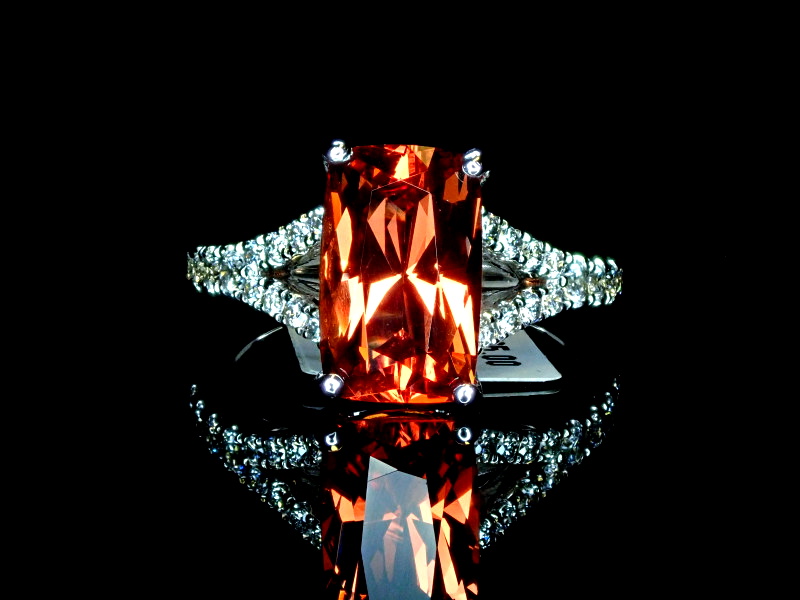 Sur la photo ci-dessus : Bague en spinelle orange
Sur la photo ci-dessus : Bague en spinelle orange
Importance historique et culturelle des pierres de naissance d'août
Techniquement, le mois d'août a trois pierres de naissance : le péridot, le spinelle et la sardonyx .
Pourquoi y a-t-il trois pierres de naissance pour août ? D'une part, toutes les listes ne proposent pas trois pierres de naissance pour août. D'autre part, les pierres de naissance ont évolué au fil du temps.
Alors, quand la pierre de naissance d’août a-t-elle changé ?
Aux Ier et Ve siècles après J.-C., les premières listes de pierres de naissance s'inspiraient des listes bibliques de 12 pierres précieuses. Dans ces listes, la pierre de naissance d'août était soit la cornaline , soit la sardoine.
Tiffany & Co a publié en 1870 une brochure de poèmes sur les pierres de naissance avec de la sardoine pour le mois d'août.
La première liste standardisée a été créée par la National Association of Jewellers (aujourd'hui Jewellers of America) en 1912. Cette liste avait la sardonyx comme principale pierre de naissance du mois d'août, avec le péridot comme alternative.
En 1937, l'Association nationale des orfèvres a publié une liste avec une priorité inversée : le péridot en premier lieu, la sardonyx en second lieu.
Plus tard, la liste de 1912 a été modifiée grâce à la collaboration de l'American Gem Trade Association et de Jewellers of America. L'un des changements a consisté à ajouter le spinelle pour le mois d'août 2016.
C'est pourquoi nous nous concentrerons sur le péridot et le spinelle dans le guide d'aujourd'hui.
L'histoire des pierres de naissance étant couverte, nous allons maintenant plonger dans l'histoire individuelle de ces pierres précieuses.
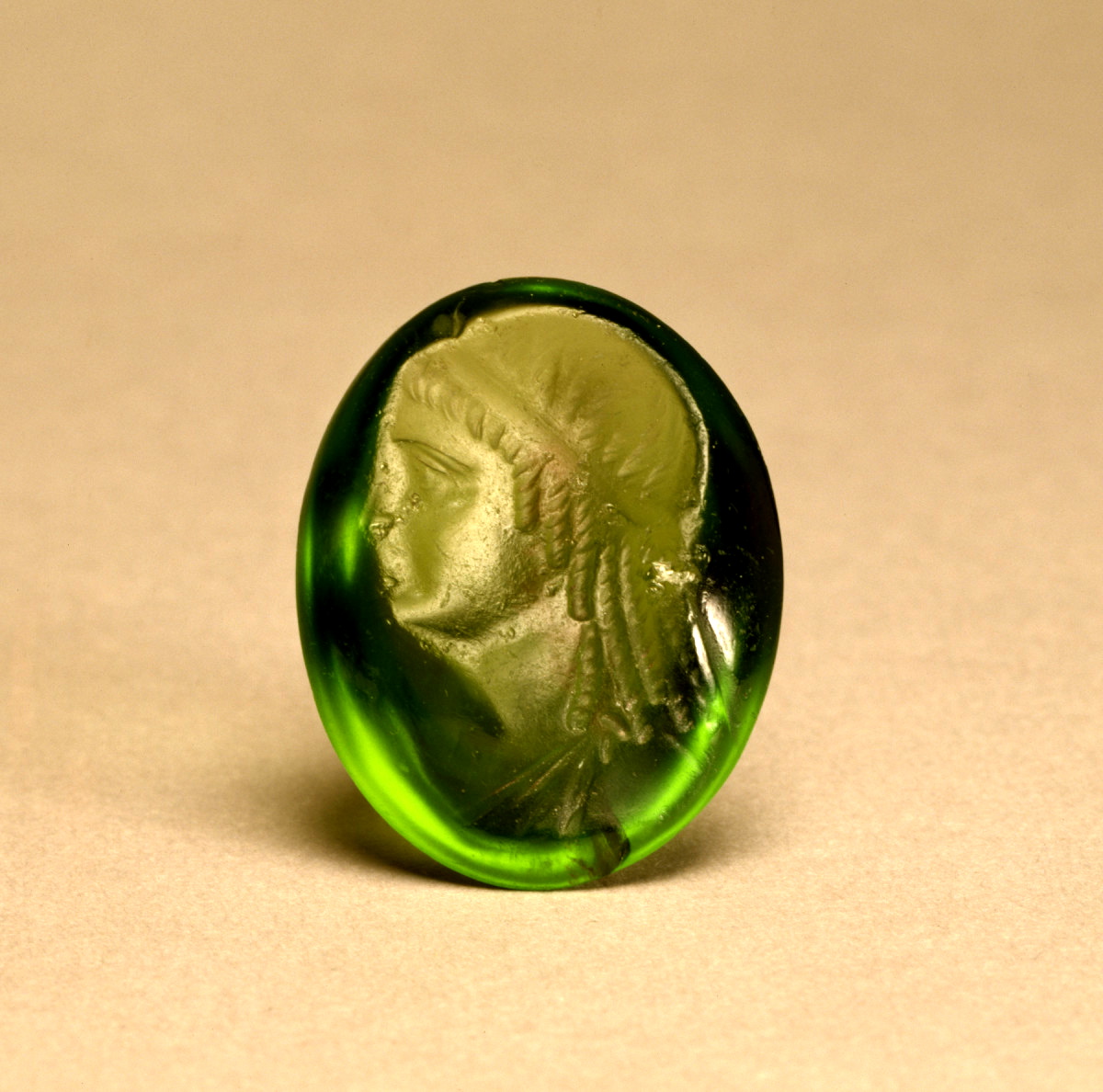 Ci-dessus : Portrait en taille-douce de Cléopâtre II, gravé en péridot, entre 175 et 115 av. J.-C. environ (époque hellénistique-ptolémaïque) | Crédit photo : Walters Art Museum, domaine public
Ci-dessus : Portrait en taille-douce de Cléopâtre II, gravé en péridot, entre 175 et 115 av. J.-C. environ (époque hellénistique-ptolémaïque) | Crédit photo : Walters Art Museum, domaine public
La riche histoire du péridot dans les cultures anciennes
L'histoire du péridot commence dans l'Égypte ancienne .
Les premières traces d'exploitation minière de péridot remontent à 1500 avant J.-C., lorsque les anciens Égyptiens ont découvert la pierre de naissance d'août sur Topazios (aujourd'hui appelée île Saint-Jean ou Zabargad).
Cléopâtre croyait que le péridot protégeait contre les forces du mal, et les prêtres égyptiens buvaient dans des coupes incrustées de péridot pour communiquer avec les dieux de la nature.
D'anciennes légendes hawaïennes associent le péridot à Pélé, la déesse du feu et des volcans. Certains mythes affirment que les péridots sont les larmes de Pélé. D'autres affirment que les pierres de naissance sont des dons de guérison de Pélé.
Historiquement, le péridot a été mélangé à de nombreuses pierres .
Le nom ancien « chrysolite » pourrait en être en partie responsable. « Chrysolite » et « topaze » étaient utilisés pour les pierres de chrysobéryl , de péridot et de préhnite de Topazios.
Une autre confusion séculaire existait entre le péridot et l'émeraude .
En fait, les Romains de l'Antiquité appelaient le péridot « Émeraude du soir ». Certains historiens pensent que la collection d'émeraudes de Cléopâtre était en réalité composée de péridots.
D'autres exemples célèbres de péridots confondus avec des émeraudes incluent :
Les pierres précieuses de 200 carats du sanctuaire des Trois Saints Rois dans la cathédrale de Cologne en Allemagne
Le collier de l'impératrice française Joséphine Bonaparte offert par son mari empereur, Napoléon — Napoléon est né en août !
Pourtant, aucune gemme ne mérite autant le titre d’« imposteur » que le spinelle.
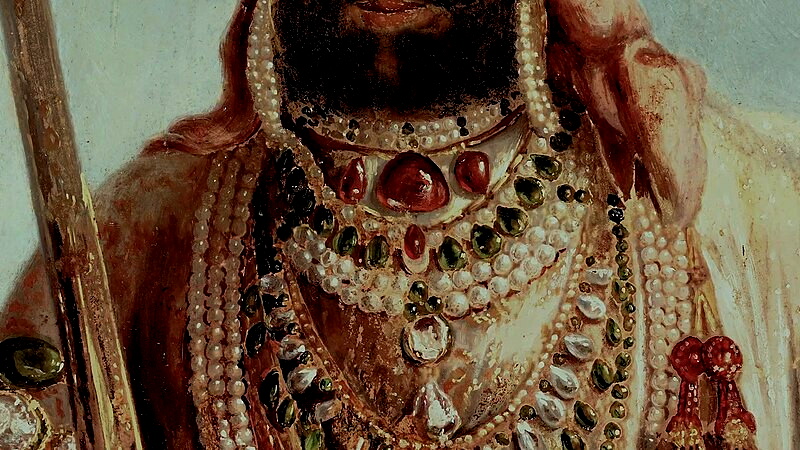 Photo ci-dessus : Détail du rubis de Timur, d'après une peinture du maharaja Sher Singh, par August Schoefft, vers 1841-1842 | Crédit photo : August Schoefft, domaine public
Photo ci-dessus : Détail du rubis de Timur, d'après une peinture du maharaja Sher Singh, par August Schoefft, vers 1841-1842 | Crédit photo : August Schoefft, domaine public
Les connexions et confusions historiques intrigantes du spinelle
Une grande partie de l'histoire du spinelle est liée à sa confusion avec des pierres précieuses , notamment le saphir et le rubis .
Historiquement, le terme « rubis » était souvent utilisé pour désigner toutes les pierres précieuses rouges . Lorsque les rubis importés furent introduits en Europe au Moyen Âge, les spinelles d'Afghanistan furent appelés « rubis balas ».
Jusqu'aux années 1800, les membres de la famille royale européenne se disputaient les « rubis Balas », même si certains érudits médiévaux les classaient comme distincts des vrais rubis.
Des exemples notables de spinelles confondus avec des rubis sont le rubis du Prince Noir et le rubis de Timur.
Le rubis du Prince Noir fut d'abord la propriété du prince de Grenade, Abu Said Faraj, au XIVe siècle. Il fut finalement acquis par le « Prince Noir » Édouard de Woodstock. Il devint la pierre centrale de la couronne impériale d'État utilisée lors du couronnement de la reine Victoria en 1838.
Le rubis de Timur (photo ci-dessus) doit son nom au souverain timouride Timur, qui aurait été pris à tort lors de l'invasion de Delhi en 1398. La propriété a été transmise à divers dirigeants moghols et sikhs jusqu'à ce que la Compagnie des Indes orientales s'en empare en 1849.
Ils l'ont offert à la reine Victoria en 1851. Elle l'a fait sertir dans un collier Garrards en 1853.
Heureusement, les spinelles ont progressivement gagné en reconnaissance en tant que belles pierres précieuses et pierres de naissance polyvalentes du mois d’août.
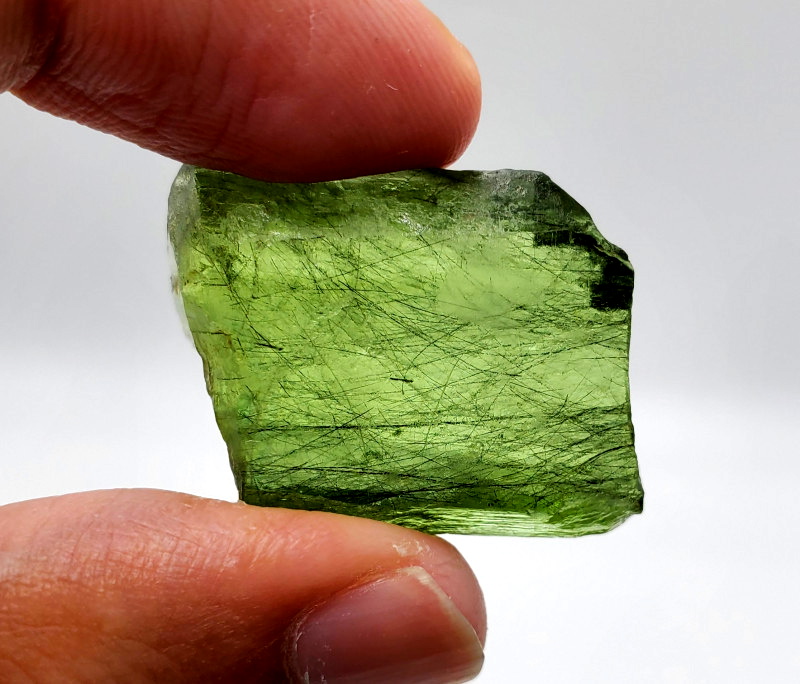 Sur la photo ci-dessus : Péridot brut avec inclusions en forme d'aiguilles
Sur la photo ci-dessus : Péridot brut avec inclusions en forme d'aiguilles
Merveille géologique : les origines du péridot et du spinelle
En commençant par le péridot , cette pierre de naissance d'août est un silicate de fer et de magnésium et la forme précieuse de l'olivine (parfois appelée chrysotile).
On trouve souvent du péridot dans les péridotites. Plus particulièrement, certains cristaux de péridot sont d'origine extraterrestre , découverts dans d'anciennes météorites ferrugineuses appelées pallasites et dans de la poussière de comète.
Aujourd'hui, la plupart des cristaux de péridot proviennent d'Arizona (États-Unis), de Birmanie, du Pakistan et du Sri Lanka. La Birmanie et l'Égypte produisent les plus grands péridots facettables.
Passons maintenant au spinelle . Cette pierre de naissance d'août est un oxyde de magnésium et d'aluminium appartenant au sous-groupe des spinelles, composé d'oxydes d'aluminium isométriques. Parmi les autres pierres de ce groupe figurent la magnétite et la gahnite, mais le spinelle est le seul membre couramment utilisé en joaillerie.
Bien que les spinelles se forment dans les roches hôtes, les mineurs les trouvent généralement dans des dépôts alluviaux, où l'eau a érodé la roche et entraîné les gemmes en aval, arrondissant souvent les cristaux en cours de route.
Les pierres de naissance en spinelle se trouvent dans le monde entier, mais les principales sources de spécimens de qualité gemme sont l'Afghanistan, le Myanmar et le Sri Lanka.
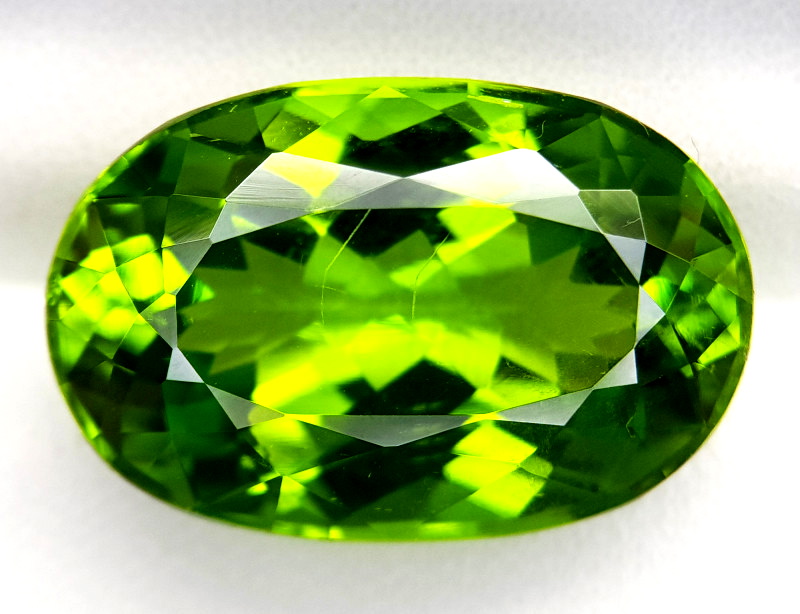 Sur la photo ci-dessus : pierre précieuse péridot à facettes
Sur la photo ci-dessus : pierre précieuse péridot à facettes
Nuances de vert et au-delà : l'éclat du péridot
Le péridot est l'une des rares pierres précieuses définies par sa coloration verte, mais les couleurs de cette pierre de naissance d'août vont en fait du vert pur au vert jaune au vert brunâtre.
Pourquoi la pierre de naissance d'août est-elle verte ? Le péridot est idiochromatique, sa couleur verte provient donc du fer ferreux (Fe2+) présent dans sa formule minérale.
Le fer ferrique (Fe3+) peut donner des nuances jaunes, tandis que le chrome peut éclaircir les teintes vertes. La teneur idéale en fer est de 12 à 15 % ; une teneur supérieure donne des couleurs plus brunes et moins valorisables.
De nombreuses gemmes péridot sont identifiées par leur origine :
Changbai, Chine : Vert citron vif
Hunan, Chine : Plus de jaune-vert
Myanmar : Vert moyen à foncé brillant et huileux
Sondmore, Norvège : Vert citron plus pâle
Cachemire, Pakistan : vert pomme ou citron vert, nuances dorées
Zabargad, Égypte : Vert moyen riche
En ce qui concerne les effets optiques , les péridots présentent très rarement un effet chatoyant (œil de chat) ou astérique (étoile). De plus, la forte biréfringence de cette pierre de naissance d'août peut entraîner un dédoublement des facettes et un flou.
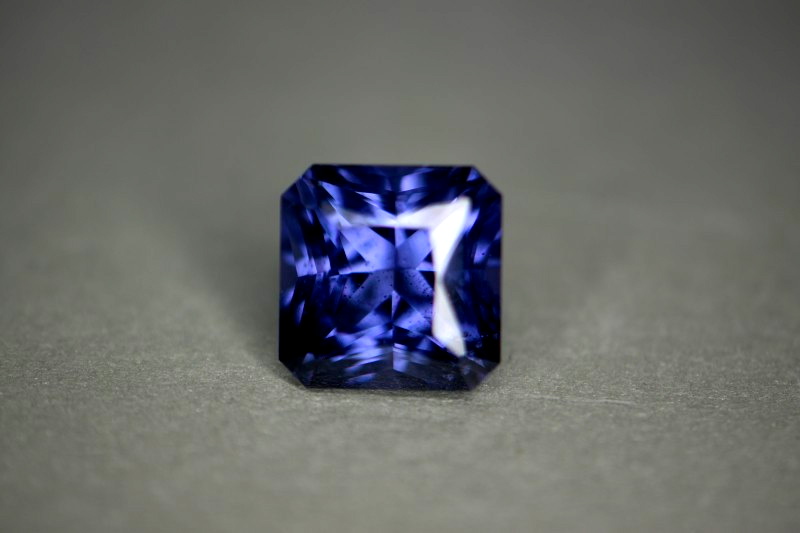 Sur la photo ci-dessus : Spinelle violet à facettes
Sur la photo ci-dessus : Spinelle violet à facettes
Les multiples couleurs du spinelle
Les couleurs des pierres de naissance du mois d'août sont très variées, incluant presque toutes les couleurs de l'arc-en-ciel et des nuances intermédiaires. La plupart des spinelles sont rouges, roses, oranges, lilas et bleus.
Les impuretés derrière les couleurs de cette pierre de naissance sont :
Chrome, fer ferrique et/ou vanadium – rouge, magenta, violet
Cobalt et/ou fer ferreux – bleu, bleu-violet, violet
Vanadium – orange, orange-rouge
Transfert de charge de fer ferreux et ferrique – vert
Oxyde de magnésium et d'aluminium – noir
Certaines impuretés et couleurs ont donné naissance à différentes variétés et noms commerciaux. Pour en savoir plus, consultez notre guide d'information sur le spinelle .
Certains spinelles du Myanmar présentent un astérisme. Plus rarement, ils peuvent changer de couleur , passant du bleu-gris ou du violet à la lumière du soleil au violet ou au violet-rougeâtre sous l'effet de l'incandescence.
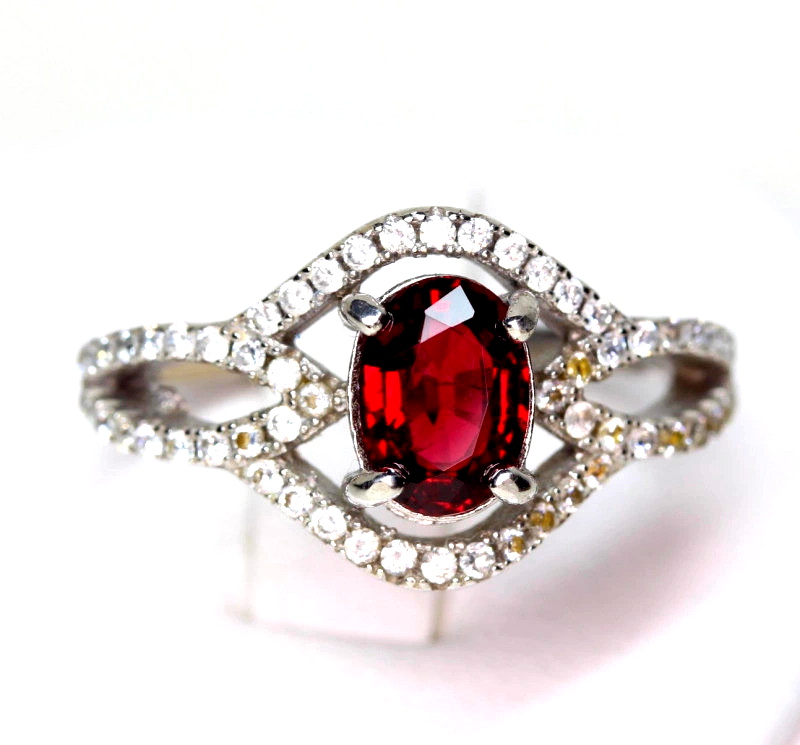 Sur la photo ci-dessus : Bague en spinelle rouge
Sur la photo ci-dessus : Bague en spinelle rouge
Évaluation de la qualité : caractéristiques du péridot et du spinelle
La qualité des pierres de naissance péridot et spinelle est évaluée en fonction de la couleur, de la clarté, de la taille et du poids en carats, ainsi que des traitements effectués.
Couleur
Péridot : Les péridots d'un vert gazon pur et vibrant sont généralement les plus précieux, suivis par les péridots d'une couleur jaune-vert modérément saturée. Les nuances jaunes sont les plus courantes. Les nuances brunes ont une valeur moindre.
Spinelle : Dans l'ordre, les spinelles les plus rares et les plus précieux sont le rouge, le bleu cobalt, le rose vif et l'orange vif.
Des options plus abordables (mais toujours aussi belles) sont les nuances de violet comme le lavande, le bleu-violet et le violet. Une saturation plus élevée est plus rare et plus précieuse.
Clarté
La pureté décrit le degré d' inclusions visibles, ce qui diminue la transparence et la valeur d'une pierre. Le péridot et le spinelle ont tous deux une pureté de type II , ce qui signifie que les spécimens de haute qualité sont généralement purs à l'œil nu (aucune inclusion visible sans grossissement).
Péridot : Sous grossissement, de nombreux péridots présentent des inclusions en forme de nénuphar, ce qui les rend plus difficiles à tailler. Un nombre réduit d'inclusions est idéal.
Spinelle : De nombreux spinelles présentent des rangées intrigantes et caractéristiques d'inclusions cristallines octaédriques. L'alignement des aiguilles de rutile crée un effet « étoile » précieux.
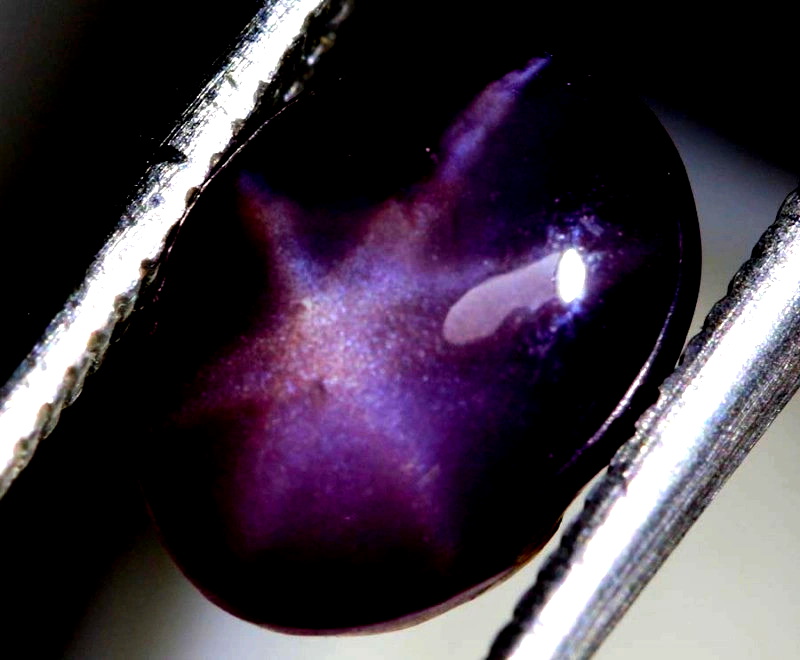 Sur la photo ci-dessus : Cabochon de spinelle étoilé violet
Sur la photo ci-dessus : Cabochon de spinelle étoilé violet
Couper
La plupart des péridots et spinelles, pierres de naissance du mois d'août, sont facettées . Les spécimens en forme d'étoile ou d'œil de chat doivent être taillés en cabochon .
Péridot : Les tailleurs de pierres précieuses doivent tenir compte de la biréfringence, de la clarté et de la couleur du péridot lors du choix de la taille facettée. Les tailles en damier peuvent masquer les inclusions, mais les tailles rondes, poires et ovales brillantes sont les plus populaires.
Spinelle : Les tailles de spinelle facettées les plus courantes sont ovales, rondes et coussinées, qui maximisent sa brillance. Les spinelles de haute qualité peuvent être taillés en tailles non calibrées.
Poids en carats
Péridot : Le péridot brut de qualité gemme dépasse rarement 3 carats, la plupart des pierres précieuses pesant moins d'un carat. Le prix au carat des pierres de plus de 3 carats est nettement plus élevé.
Spinelle : La plupart des spinelles actuels pèsent moins de 5 carats. Les pierres de plus de 5 carats ont un prix au carat nettement plus élevé, notamment les spinelles bleus, rouges et roses.
Traitements
Péridot : Les traitements sont rares pour le péridot, bien que certains soient recouverts d'une feuille de métal pour améliorer la couleur et la durabilité.
Spinelle : La plupart des spinelles naturels ne sont pas traités. Plus rarement, certains sont chauffés et comblés pour une meilleure clarté. Divers traitements de diffusion peuvent être utilisés pour créer des couleurs artificielles comme le bleu cobalt.
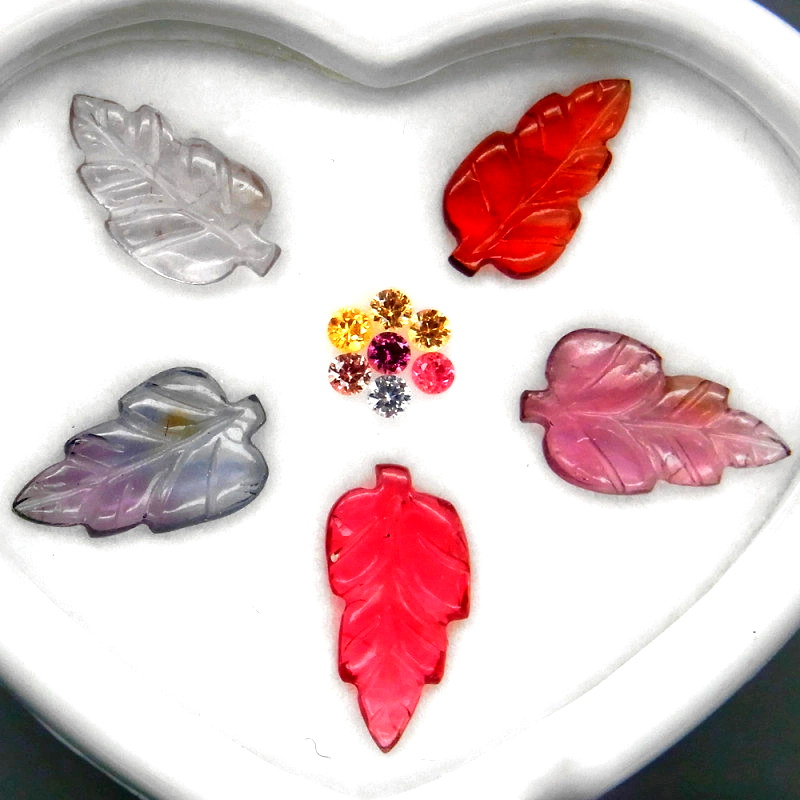 Sur la photo ci-dessus : Spinelles sculptés autour de saphirs facettés
Sur la photo ci-dessus : Spinelles sculptés autour de saphirs facettés
Importance culturelle et croyances
Le péridot et le spinelle ne sont pas seulement magnifiques : ces pierres de naissance d'août sont également importantes sur le plan métaphysique.
Péridot
Historiquement, le péridot était souvent associé à la lumière et à la protection.
Les Égyptiens de l'Antiquité l'appelaient la « joie du soleil » et la portaient pour se protéger des « terreurs de la nuit ». Certains anciens pensaient que le péridot provenait d'une explosion solaire.
L'écrivain du XVIe siècle Heinrich Cornelius Agrippa affirmait que tenir le péridot devant le soleil lui permettrait de refléter une étoile dorée qui guérirait les problèmes respiratoires.
Certains pensent que le péridot dissipe les cauchemars, la folie et les pertes de mémoire. D'autres affirment que son « éclat intérieur » apporte clarté mentale et conscience spirituelle.
Aujourd'hui, la pierre de naissance du mois d'août, le péridot, symbolise le renouveau, la protection et l'harmonie.
Spinelle
Pour le spinelle, la signification de cette pierre de naissance d'août est liée à l'amour et au rajeunissement.
En tant que pierres de guérison , les spinelles sont censés favoriser la passion, la dévotion et le bonheur, tout en diminuant l'anxiété et en équilibrant les émotions.
Les surnoms métaphysiques du spinelle incluent :
Pierre de l'espoir
Pierre de joie
Pierre de revitalisation
Pierre d'immortalité
Sur le plan spirituel, certains utilisent le spinelle pour stimuler l'intuition et la communication avec les royaumes célestes. Au Myanmar, on dit que les cristaux de spinelle sont nat thwe , ce qui signifie « polis par les esprits ».
La pierre de naissance d'août est également utilisée pour ouvrir le chakra racine et redynamiser le porteur.
Approvisionnement éthique et durabilité
La sensibilisation croissante aux diamants de conflit pourrait amener les consommateurs conscients à s’interroger sur l’éthique et la durabilité de l’extraction du péridot et du spinelle.
Une responsabilité partielle incombe aux bijoutiers, qui peuvent choisir d'acheter auprès de petites mines indépendantes et contrôlées, transparentes sur leur chaîne d'approvisionnement. L'autre responsabilité incombe aux acheteurs, qui peuvent choisir de n'acheter les pierres de naissance du mois d'août qu'auprès de bijoutiers contrôlés et transparents.
Heureusement, environ 80 à 95 pour cent des pierres précieuses péridot sont exclusivement extraites par les membres de la tribu Apache de la réserve Apache de San Carlos en Arizona, aux États-Unis, une exploitation indépendante ouverte aux visiteurs.
De nombreux bijoutiers optent pour des spinelles provenant de Tanzanie et du Sri Lanka, où les pratiques minières sont transparentes et ne sont pas associées à des violations des droits de l’homme.
De nombreux acheteurs se sont tournés vers les versions synthétiques des pierres de naissance d’août, qui ont les mêmes propriétés chimiques et physiques que les matériaux naturels mais sont créées en laboratoire.
En fait, les spinelles synthétiques comptent parmi les pierres précieuses créées en laboratoire les plus courantes. Le péridot synthétique est moins courant.
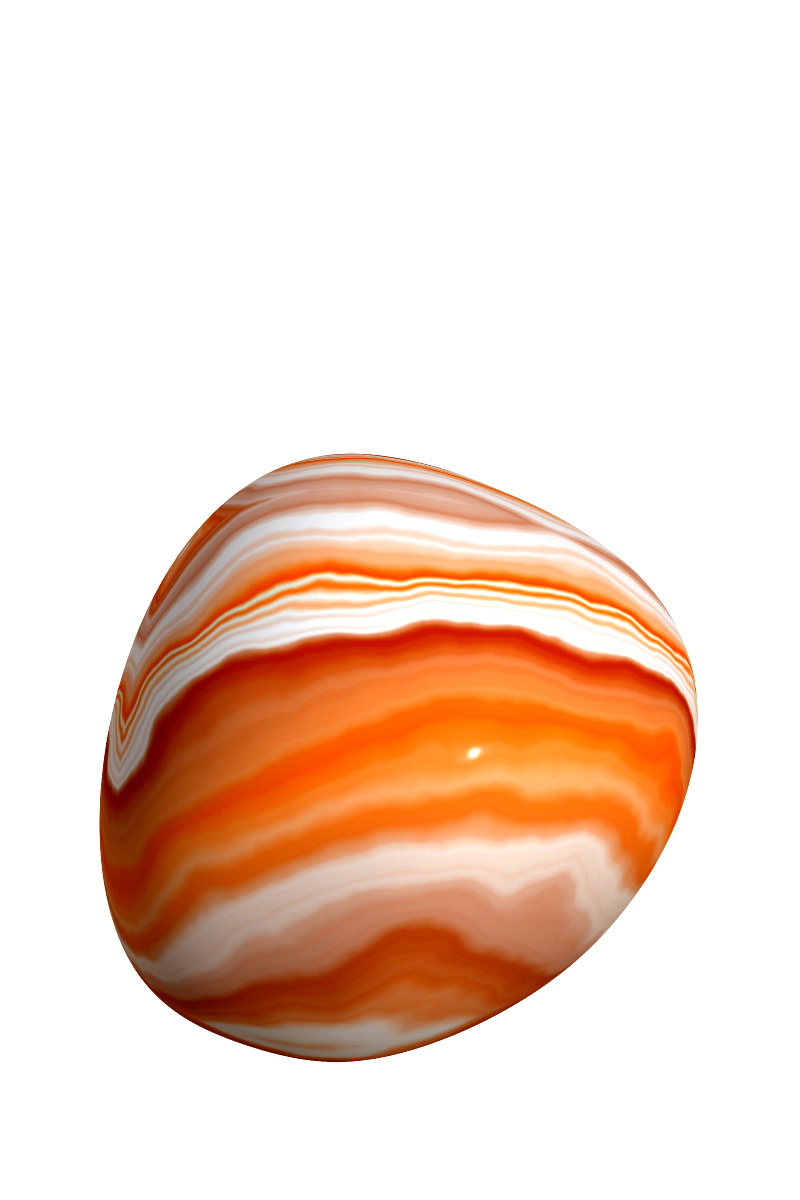 Sur la photo ci-dessus : cabochon de sardonyx
Sur la photo ci-dessus : cabochon de sardonyx
Pierres de naissance alternatives pour août
Comme mentionné précédemment, de nombreuses listes incluent une troisième pierre de naissance d'août, à savoir la sardonyx, une variété de calcédoine composée de couches de sardine et d'onyx , ou la cornaline, une variété de calcédoine similaire.
Le spinelle lui-même est souvent un simulant d'autres pierres précieuses, mais le péridot possède de nombreux simulants abordables, comme :
corindon synthétique
Préhnite
Astrologiquement, quelle est la pierre de naissance de la Vierge en août ? Parmi les pierres de naissance traditionnelles, les Vierges, signe de terre, préféreront peut-être un péridot vert gazon.
Quelle est la pierre de naissance du Lion ? Les Lions nés en août pourraient préférer la passion du spinelle, en particulier le spinelle rouge ardent.
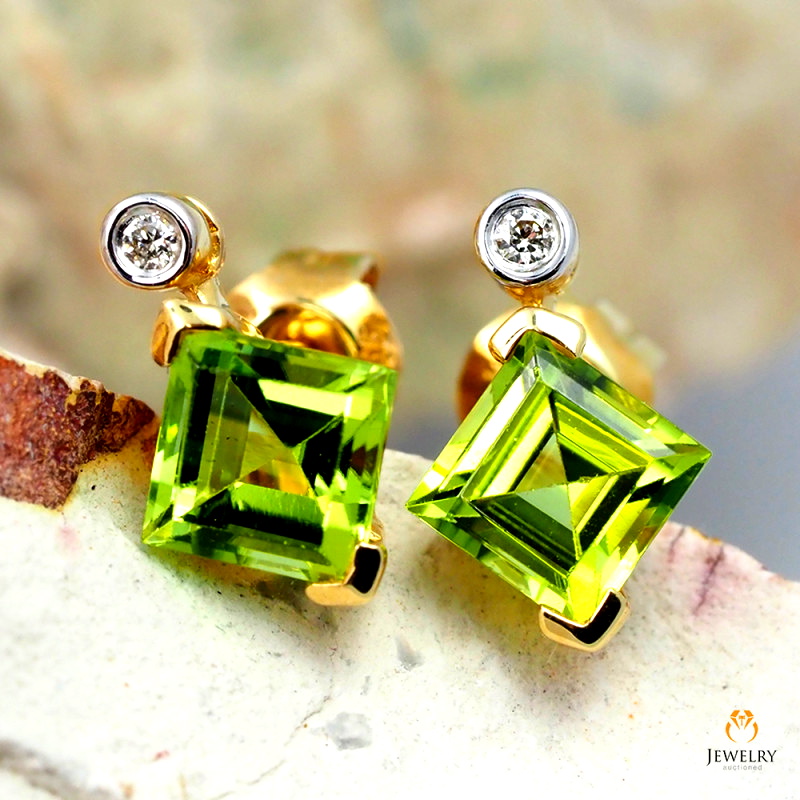 Sur la photo ci-dessus : Boucles d'oreilles en péridot à facettes
Sur la photo ci-dessus : Boucles d'oreilles en péridot à facettes
Cadeaux personnalisés avec pierre de naissance d'août
Offrir une pierre de naissance d'août est une façon attentionnée de célébrer la vie de l'être aimé. Une fois la pierre choisie, il est temps de choisir le bijou ou l'accessoire qui lui correspondra le mieux.
Voici quelques idées :
Bague empilable avec pierre de naissance d'août
Collier avec pierre de naissance et pendentif monogramme de leur initiale
Bague en tungstène avec pierre de naissance intégrée
Boucles d'oreilles à tige avec pierre de naissance dans leur forme préférée
Décor de pierre de naissance sculptée
Porte-clés avec pierre de naissance d'août
Ce qui compte le plus, c’est que votre don soit significatif et vienne du cœur !
Quelle pierre de naissance d’août adorez-vous ?
Le spinelle et le péridot peuvent sembler différents, mais ils se ressemblent plus qu'on ne le pense. Tous deux représentent la lumière et le renouveau, et ont été confondus avec d'autres pierres précieuses. Avec la sardoine, ces pierres de naissance d'août offrent un éventail de possibilités pour célébrer les personnes nées à la fin de l'été !
Rechercher le Gemstone Encyclopedia
Enchères associées
Articles Liés
Il existe des dizaines de quartz et de calcédoine aux couleurs et motifs variés. Découvrez les propriétés du quartz et tous ses types, de l'améthyste et l'agate au quartz plasma et au quartz fantôme !
15th Oct 2020
Les émeraudes Gota De Aceite possèdent une particularité qui augmente leur valeur. Apprenez-en plus sur ce type d'émeraude rare et découvrez comment elle augmente sa valeur.
9th May 2018
Laissez-nous vous expliquer comment acheter des pierres précieuses sur Internet. Nous proposons la plus grande sélection de pierres précieuses sur Internet, et cela peut être un peu compliqué au début. Laissez-nous vous guider avec quelques conseils utiles.
3rd Oct 2018
Derniers articles
Découvrez l'histoire, les propriétés, la valeur et les conseils d'entretien de la pierre de sang de poulet, une pierre précieuse rare et éclatante, prisée pour ses motifs rouges saisissants et sa signification culturelle.
8th Dec 2025
La gaylussite est un minéral rare, principalement utilisé dans l'industrie, car elle se trouble facilement en se déshydratant. Découvrez l'histoire, les propriétés, les utilisations et les caractéristiques de la gaylussite dans ce guide complet.
7th Dec 2025
La chiolite est un minéral rare, incolore à blanc, apparenté à la cryolite. Les gemmes sont très rares et proviennent de quelques gisements seulement. Découvrez ici les utilisations, l'histoire, les prix et les caractéristiques de la chiolite.
5th Dec 2025
Catégories d'articles
How To's is where you will find helpful articles from gem Rock Auctions on how to cut gemstones, select gemstones and buy gemstones.
9 les articles




